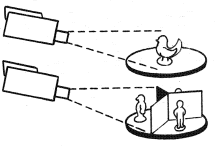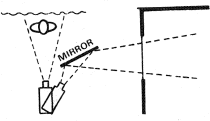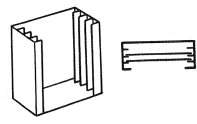Stretching the Facilities
When you are shooting ‘live’ continuous action, there will be times when you want to do just a little more than your facilities allow.
Even in a multi-camera setup, a fast-moving sequence can find the director taking shots quicker than the cameraman can set up new ones! And then there are occasions when there is insufficient time to move a camera to its new viewpoint, or obstructions such as floor cables impede a camera move. A live single camera setup can be very restrictive.
With a little ingenuity, you can improve such situations, and provide a rapid succession of different shots, despite restrictions.
Useful devices
• Using inserts. The simplest method of stretching facilities is to switch to a videotape or film insert, while repositioning the camera(s). As well as the more obvious kinds of insert, such as an illustrative sequence, you can introduce recorded cutaway shots of an audience, a detail shot showing closeup views of the subject, or even a reaction shot (nod shot) of the anchor person taped during rehearsal.
Similarly, you could cut to a slide scanner showing some appropriate subject, such as a map or a graphic. Even a brief animated graphic or decorative effect from a desktop video/computer may be sufficient to reposition the camera or change the shot.
• Rapid intercutting. If you are showing a series of items, and want to intercut between them quite quickly, arrange them in arcs at equal distances from the cameras, so that all they have to do is to pan between objects without moving position.
• Turntable. This is a simple yet effective way to present items. Place the subject in the centre of a revolving turntable, and you can show all sides of it, without having to laboriously arc the camera round it. Alternatively, you can use the turntable to present a series of small displays in quick succession.
• Front-projected slides. Project a photo-slide onto a screen, and the camera can take in the whole or part of the picture, or explore around the projected image. You can even insert this picture into another camera’s shot as a chromakeyed background.
• Mirror. A carefully placed mirror allows you to pan the camera from one subject to another that is reflected in the mirror. The effect is a ‘pushover wipe’.
• Pull-out graphics. Used since the earliest days, a grooved box holding a series of pull-out graphics (graphs, titling, mattes) still has its uses.
Quick pans
Rapid intercutting is possible, if cameras pan quickly between equidistant items.
Turntables
Turntables enable varioys aspects to be seen easily, or to provide rapidly changed displays.
Front projected slides
A compact device for projecting and shooting slides uses a 4S°

Instant repositioning
With a quick pan to a mirror, the camera is virtually repositioned to a new viewpoint.

Pull-out graphies
Using a series of pull-out graphics in a grooved box, rapid changes are possible.



